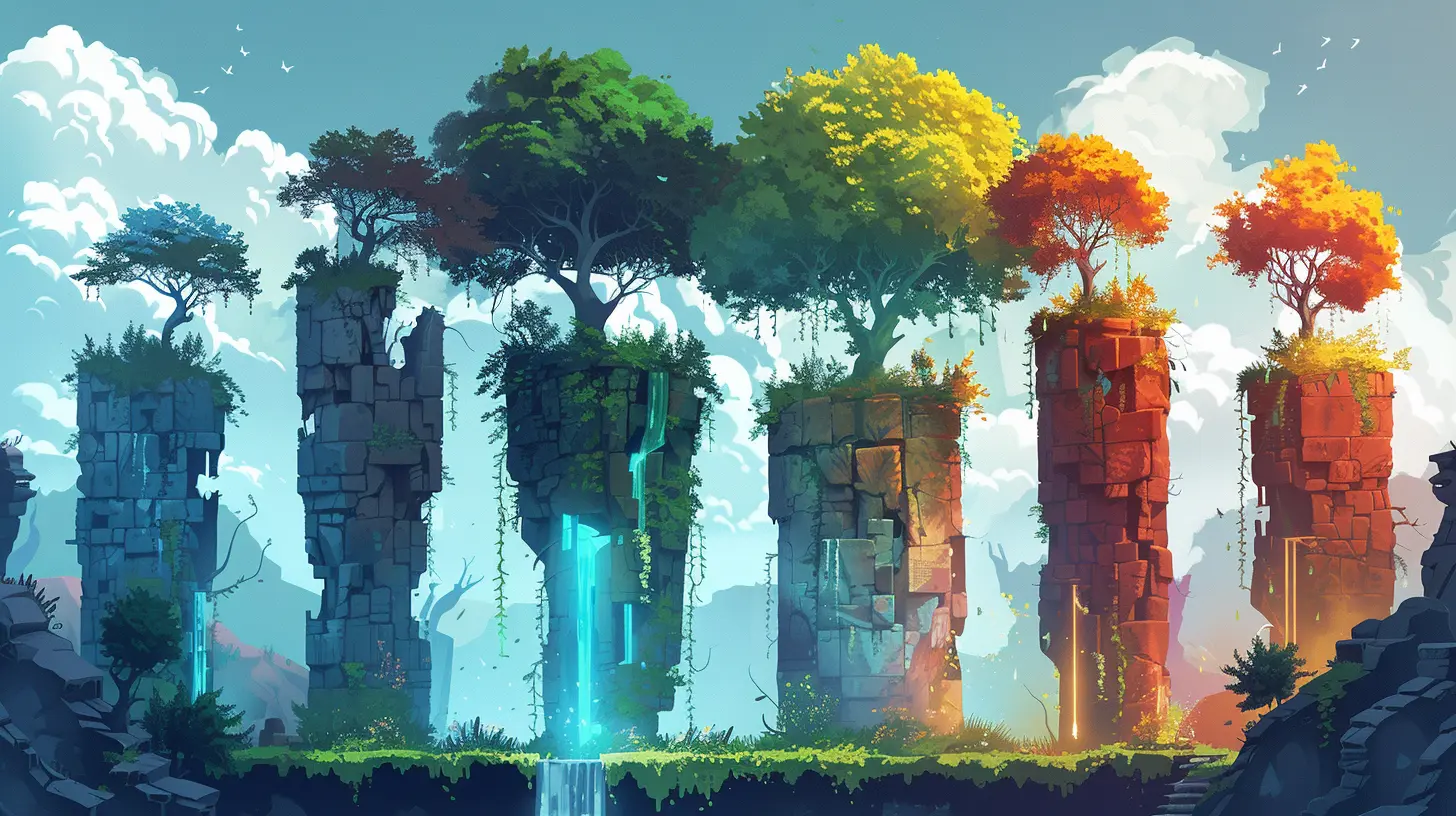Crafting Challenging Yet Fair Game Levels for Different Skill Tiers
24 April 2025
Video games have this magical ability to pull us into fantastical worlds, make time fly, and test our limits. But here’s the thing: the glue that holds any great gaming experience together is level design. Have you ever played a game where one level felt unnecessarily unforgiving or where another was so easy it felt like a cakewalk? Yeah, we’ve all been there. That imbalance can seriously ruin the vibe of a game.
So, how do developers create levels that are challenging yet fair for a diverse group of players with varying skill levels? Well, spoiler alert: it's no easy task. It’s like walking a tightrope, balancing difficulty and accessibility without alienating anyone. Let’s dig into the nitty-gritty of how to nail this art of level design. 
Understanding Your Audience: Know Who’s Playing
Before you even think about crafting a level, you've got to understand your audience. Who’s playing your game? Are they casual gamers who just want to chill after work? Hardcore fans hungry for the next big challenge? Or are you trying to cater to both?Knowing your players' skill levels will shape the foundation of your game design. For instance, newer players might appreciate slower-paced levels with clear objectives. On the flip side, veteran players live for high-stakes challenges and intricate mechanics. If you try to force-feed a one-size-fits-all difficulty, you risk losing both groups.
So, step one? Define your target audience. If you're going for all skill levels, buckle up—this is where things get interesting. 
The Goldilocks Principle: Not Too Easy, Not Too Hard
Ever heard of the Goldilocks principle? It’s all about finding that sweet spot — not too easy, not too hard, but just right. The same concept applies to level design.You want your players to feel challenged but not frustrated. When levels are so easy that players breeze through without breaking a sweat, they get bored. When they’re so difficult that players repeatedly fail with no clear path to success, they’ll toss their controller across the room (maybe literally).
Here’s the trick: design with progression in mind. Start with simpler levels, gradually ramping up difficulty as the player learns the mechanics. Think of it like teaching someone to climb. You don’t take them straight to the tallest peak; you start with smaller hills and let them build confidence. 
Layered Difficulty: Designing for All Skill Tiers
Okay, here’s where it gets tricky. How do you design for skill tiers without dumbing down the challenge for pros or overwhelming beginners? Enter layered difficulty. This strategy lets you cater to everyone, no matter their skill set.1. Optional Challenges for the Die-Hards
Throw in extra challenges off the beaten path for your hardcore players. Think hidden collectibles, secret rooms, or bonus objectives. For example, in the “Super Mario” games, beginners can focus on reaching the flagpole while completionists go after every coin and secret exit.2. Assist Features for Newbies
Let’s face it, not everyone is a born gamer. Include features like tutorials, tooltips, or hints to give newer players a little boost. Some games like “Celeste” even have an “Assist Mode” to simplify complex mechanics without compromising the core experience for advanced players.3. Dynamic Difficulty Adjustment (DDA)
If you want to get fancy, you can incorporate dynamic difficulty. This system subtly adjusts the game based on how well the player is performing. For instance, enemies’ attack patterns might become more predictable for struggling players or more erratic for veterans breezing through. It’s like a secret, invisible guide holding your hand just enough to keep you moving forward.
The Art of Building Fair Challenges
Alright, now for the million-dollar question: how do you build levels that feel both fair and fun? Nobody likes cheap shots—those moments where you feel like the game stacked the deck against you. Fair gameplay is when the player feels like every failure is on them, not the game.Here’s how to make that happen:
1. Clarity is Key
Imagine jumping into a new level and having no idea what’s happening or where to go. Frustrating, right? Players shouldn’t have to guess the rules. Use visual cues, lighting, and level layout to subtly guide them. Games like "Portal" are masters at teaching you mechanics through gameplay rather than text-heavy tutorials.2. Reward Skill, Not Luck
Skill-based challenges are the bread and butter of fair level design. If a player fails, it should be because they made a misstep, not because the game threw a random curveball. For example, platformers like “Hollow Knight” test precision timing but never punish you unfairly.3. Give Players Time to Adapt
When introducing new mechanics or enemies, don’t immediately throw them into the deep end. Give them a sandbox to experiment first. For instance, if you add a new enemy type, start with a solo encounter before ramping up the difficulty in later encounters.Playtesting: Your Secret Weapon
Once you’ve built your level, let people play it—a lot. No, seriously, playtesting is the holy grail of game design. Why? Because your players will interact with your levels in ways you’d never expect.Things to Watch During Playtesting:
1. Difficulty Spikes: Are there sections where players are dying more than usual?2. Flow: Are players smoothly progressing, or are they getting stuck too often?
3. Fun Factor: Are they enjoying themselves, or are they ready to rage-quit?
Listen to their feedback (even if it stings) and tweak accordingly. After all, the goal is to create levels that people actually want to play.
Designing Levels That Tell a Story
Level design isn’t just about gameplay; it’s also a storytelling tool. A well-crafted level will pull players into the narrative without a single line of dialogue.Let’s look at games like “The Last of Us” or “Dark Souls.” Their level designs are dripping with storytelling details. The environment speaks volumes—whether it’s the remnants of a brutal battle or the eerie quiet of an overgrown city.
When crafting your own levels, think about the story you want to tell. Use architecture, lighting, and even enemy placement to immerse players in your world.
The Role of Feedback Loops
Ever noticed how some games make you feel smarter as you play? That’s the magic of positive feedback loops. Give your players small wins along the way to keep them hooked.For example, completing a mini-puzzle might unlock a shortcut, or defeating a challenging enemy could reward them with a powerful item. These little victories create a sense of accomplishment and keep players motivated to push forward.
Iteration is Everything
You know what they say: Rome wasn’t built in a day, and neither are great game levels. The best level designers don’t get it right on the first try—or the second, or the third. They iterate.Test the waters with your design, gather feedback, and refine, refine, refine. Level design is a process, not a one-and-done deal. So embrace the grind—it’s worth it.
Final Thoughts
Crafting challenging yet fair game levels for different skill tiers is no walk in the park. It’s a balancing act that requires understanding your audience, mastering the art of difficulty, and continuously learning from player feedback. But when done right? Oh man, it’s so rewarding.Remember, a well-designed level isn’t just about throwing obstacles in players’ way; it’s about giving them the tools and opportunities to rise above those obstacles. Challenge them, respect their time, and, most importantly, make it fun.
all images in this post were generated using AI tools
Category:
Game DevelopmentAuthor:

Avril McDowney
Discussion
rate this article
4 comments
Orionis Dillon
Balancing challenge and fairness is crucial in level design. Tailoring obstacles to diverse skill tiers fosters inclusivity, enhances player engagement, and encourages growth, making the gaming experience rewarding and enjoyable for all.
May 22, 2025 at 2:50 AM

Avril McDowney
Absolutely! Striking the right balance between challenge and fairness not only cultivates inclusivity but also enriches the overall gaming experience for players of all skill levels. Thank you for your insightful comment!
Zeth Cooper
Great article! Balancing challenge and fairness is crucial in game design, and you’ve captured that perfectly. It’s inspiring to see how thoughtful level crafting can enhance player experience across all skill tiers. Keep up the fantastic work—your insights will definitely benefit many developers!
May 7, 2025 at 2:45 PM

Avril McDowney
Thank you for your kind words! I'm glad you found the insights helpful—balancing challenge and fairness is indeed key to enhancing player experience.
Colin Wright
Great insights on balancing difficulty! Crafting levels that cater to various skill tiers not only enhances player engagement but also promotes inclusivity. It's vital for developers to consider diverse player experiences to create a truly rewarding gaming environment.
May 2, 2025 at 3:53 PM

Avril McDowney
Thank you! I’m glad you found the insights valuable—creating inclusive levels is essential for enhancing player enjoyment and engagement.
Zevonis Miller
Great insights! Balancing challenge with fairness is crucial for player engagement. Your understanding of skill tiers shows a deep respect for gamers' diverse abilities. Keep up the fantastic work!
May 2, 2025 at 3:10 AM

Avril McDowney
Thank you for your kind words! I'm glad you found the insights valuable. Balancing challenge and fairness is essential for enhancing player experience.



